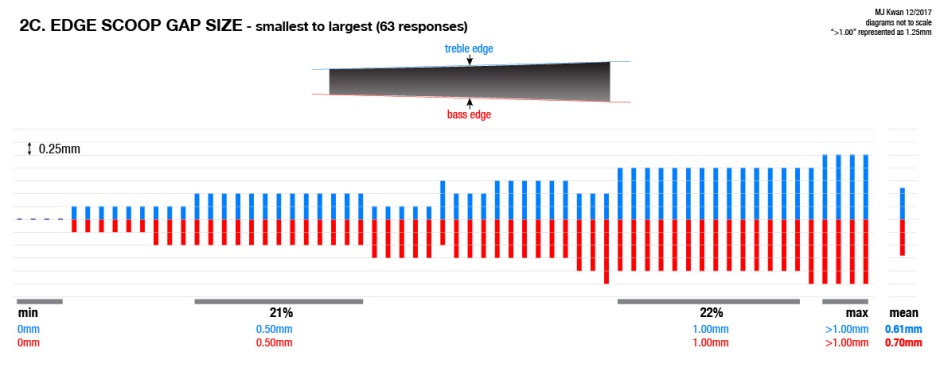Here are the results of the survey, with 67 responses collected between 12/19 – 12/25.
Participants were asked pick answers that best described their mental model of a typical violin fingerboard. If their concept of fingerboard dimensions were not well-described by the given answers, they were asked to pick the closest answer and elaborate about discrepancies in the comments section.
Fingerboard radius

Remarks from participants who selected…
Option one (one radius all the way):
I initially plane a consistent radius but this is slightly altered in the middle portion as a result of asymmetrical scooping. –Mitch McCarthy
Essentially an adjustment to the position relative to the centerline in combination with an adjustment to its height of said radius along the length gives the resultant change in width and edge heights.
Option two (flatter curve at the nut end):
Roundness at the bridge end keeps the middle strings from being in a hole in the upper positions (the string doesn’t need to be depressed as far) making double stopping and bowing easier. Flatter at the nut means the left hand doesn’t have to climb over the strings and chords are easier to play cleanly.
… more flat closer to the nut to give a “security sensation” to the musician, I meant for their finger to press the string, I think that my base of my concept the relation with the bridge radius. –Martin Cruz Aragon
Option three (one radius at nut & bridge ends, tighter curve in between):
I’ve made fingerboards for respected [players] that prefer an even radius along the whole board, but there will wind up being more scoop on the center strings, which makes the string heights higher than the g string in the middle of the board.
I actually make the board 42 at the bridge end slightly tighter in the middle and slightly flatter at the nut. –Nathan Slobodkin
Option four (narrower curve at nut end):
The radius is tighter at the nut, and then flattens out as it widens toward the bridge, allowing dead purchase for double stops and such in high positions. –Chris Jacoby
I am limiting this analysis to arcs, but some participants noted that their cross-sectional profiles were not arcs (parabolic, “egg-shaped,” etc).
String scoop gap size


Many players commented that string scoop was dependent upon various factors: string heights, string diameter and properties, player preference & style of playing, etc.
Edge scoop gap size

The treble and bass scoop gaps were symmetrical for the majority of responses.
For asymmetrical edge scoops, bass side was deeper than treble for all but one participant, who explains that:
… reaching over the strings comes from the treble side of the board so I put a little more scoop on this side to facilitate this action.
Apparent edge thickness
One participant remarks:
I make the edge thickness the same instead of measuring side scoop.
Those who use edge scoop to achieve uniform edge thickness would need a deeper edge scoop for deeper string scoops, explaining why most asymmetrical responses have heavier gaps on the bass side.
This is also observable in general by correlating string scoop and edge scoop:


Lifting the floor of the bridge end of the fingerboard is another method for achieving a more uniform edge thickness.
String scoop symmetry

Remarks:
I try to get a consistent radius curve throughout the scooping. That means that, for me, scoop centering is irrelevant.
… generally centered on fb, if anything slightly towards nut with the thought that the further away from the bridge the fingering point is, the smaller the angle between the string and fingerboard, requiring more clearance. –Mitch McCarthy
With a bit of thought, it’s apparent that scoop is only important close to nut. –Jim Biggs
I did not receive comments about scoop centering from participants who bias the depth toward the bridge.
Priority rankings

Many participants cited player style and player preference as the main determining factors for the dimensions used. The overall highest ranked factors are string scoop size and radius fidelity.
Coming soon…
The geometric interactions between scoop gap and the radius at nut, middle, and end will be discussed in greater depth in my next post.
Thanks to everyone involved in this survey.

















